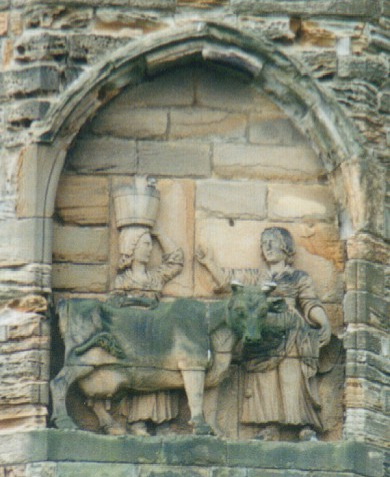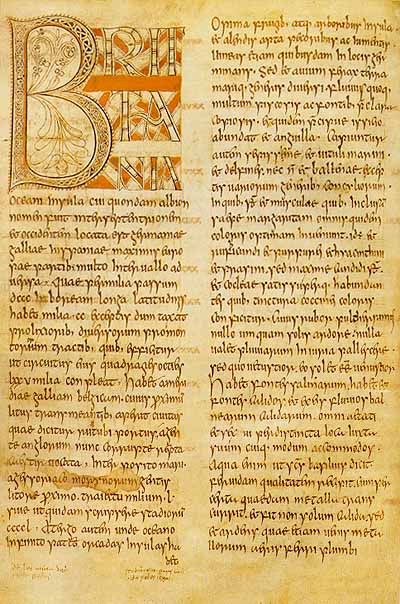|
Oswald Of Northumbria
Oswald (; c 604 – 5 August 641/642Bede gives the year of Oswald's death as 642. However there is some question of whether what Bede considered 642 is the same as what would now be considered 642. R. L. Poole (''Studies in Chronology and History'', 1934) put forward the theory that Bede's years began in September, and if this theory is followed (as it was, for instance, by Frank Stenton in his notable history ''Anglo-Saxon England'', first published in 1943), then the date of the Battle of Heavenfield (and the beginning of Oswald's reign) is pushed back from 634 to 633. Thus, if Oswald subsequently reigned for eight years, he would have actually been killed in 641. Poole's theory has been contested, however, and arguments have been made that Bede began his year on 25 December or 1 January, in which case Bede's years would be accurate as he gives them.) was List of monarchs of Northumbria, King of Northumbria from 634 until his death, and is venerated as a saint, of whom ther ... [...More Info...] [...Related Items...] OR: [Wikipedia] [Google] [Baidu] |
Durham Cathedral
Durham Cathedral, formally the , is a Church of England cathedral in the city of Durham, England. The cathedral is the seat of the bishop of Durham and is the Mother Church#Cathedral, mother church of the diocese of Durham. It also contains the shrines of the Anglo-Saxons, Anglo-Saxon saints Cuthbert and Bede. There are daily Church of England services at the cathedral, and it received 727,367 visitors in 2019. It is a grade I listed building and forms part of the Durham Castle and Cathedral World Heritage Site. The cathedral is the successor to the Anglo-Saxon Lindisfarne Priory, which was established but abandoned in 875 in the face of Viking Age, Viking raids. The monks settled at Chester-le-Street from 882 until 995, when they moved to Durham. The cathedral remained a monastery until it was Dissolution of the monasteries, dissolved in 1541, since when it has been governed by a Dean of Durham, dean and Chapter (religion), chapter. The cathedral precinct formed part of Durham ... [...More Info...] [...Related Items...] OR: [Wikipedia] [Google] [Baidu] |
Æthelfrith Of Northumbria
Æthelfrith (died ) was King of Bernicia from c. 593 until his death around 616 AD at the Battle of the River Idle. He became the first Bernician king to also rule the neighboring land of Deira, giving him an important place in the development and the unification of the later kingdom of Northumbria. Reigning from the late 6th century until his death, he was known for his military campaigns against the Britons and his victory over the Gaels of Dál Riata. His most famous victory came at the Battle of Chester, where he decisively defeated a coalition of British forces, significantly weakening the influence of the native Britons in northern England. Æthelfrith's rule marked a turning point in the consolidation of Northumbria as a dominant force in early medieval Britain. He was killed in battle against a coalition led by Rædwald of East Anglia, who placed Edwin, the exiled heir of Deira, on the throne. His line was eventually restored to power in the 630s. Background Æt ... [...More Info...] [...Related Items...] OR: [Wikipedia] [Google] [Baidu] |
Dál Riata
Dál Riata or Dál Riada (also Dalriada) () was a Gaels, Gaelic Monarchy, kingdom that encompassed the Inner Hebrides, western seaboard of Scotland and north-eastern Ireland, on each side of the North Channel (Great Britain and Ireland), North Channel. At its height in the 6th and 7th centuries, it covered what is now Argyll ("Coast of the Gaels") in Scotland and part of County Antrim in Northern Ireland.Clancy, Thomas Owen, "Philosopher King: Nechtan mac Der Ilei," SHR 83 (2004): 135–149 After a period of expansion, Dál Riata eventually became associated with the Gaelic Kingdom of Alba.''Oxford Companion to Scottish History'' pp. 161–162, edited by Michael Lynch, Oxford University Press. . In Argyll, it consisted of four main clan, kindreds or tribes, each with their own chief: the Cenél nGabráin (based in Kintyre), the Cenél nÓengusa (based on Islay), the Loarn mac Eirc, Cenél Loairn (who gave their name to the district of Lorne, Scotland, Lorn) and the Cenél Comgai ... [...More Info...] [...Related Items...] OR: [Wikipedia] [Google] [Baidu] |
Battle Of The River Idle
The Battle of the River Idle was a major victory for Rædwald of East Anglia over Æthelfrith of Northumbria in 616 in what is now Nottinghamshire. Background Æthelfrith was King of Bernicia from c. 593. Around 604 under unknown circumstances, he gained control of neighbouring Deira, and forced into exile two notable members of the Deiran royal family, Edwin, son of the former king Ælla, and Hereric, Edwin's nephew. Hereric was poisoned while at the court of Ceretic, king of Elmet. It was probably Æthelfrith who is to blame for this killing. The second exile, Edwin, ended up eventually under the protection of Rædwald in East Anglia. Æthelfrith sent messengers to Rædwald asking him to kill Edwin. Rædwald did not comply, and instead, he raised an army to confront Æthelfrith. Battle Rædwald assembled an army and marched north, accompanied by his son Rægenhere, to confront Æthelfrith. They met on the western boundary of the kingdom of Lindsey, on the east bank o ... [...More Info...] [...Related Items...] OR: [Wikipedia] [Google] [Baidu] |
Ecclesiastical History Of The English People/Book 3
{{Short pages monitor ... [...More Info...] [...Related Items...] OR: [Wikipedia] [Google] [Baidu] |
Historia Ecclesiastica Gentis Anglorum
The ''Ecclesiastical History of the English People'' (), written by Bede in about AD 731, is a history of the Christian Churches in England, and of England generally; its main focus is on the growth of Christianity. It was composed in Latin, and is believed to have been completed in 731 when Bede was approximately 59 years old. It is considered one of the most important original references on Anglo-Saxon history, and according to some scholars has played a key role in the development of an English national identity. Overview The , or ''An Ecclesiastical History of the English People'', is Bede's best-known work, completed in about 731. The first of the five books begins with some geographical background and then sketches the history of England, beginning with Julius Caesar's invasion in 55 BC. A brief account of Christianity in Roman Britain, including the martyrdom of St Alban, is followed by the story of Augustine of Canterbury, Augustine's mission to England in 597, which brou ... [...More Info...] [...Related Items...] OR: [Wikipedia] [Google] [Baidu] |
Battle Of Maserfield
The Battle of Maserfield, () was fought on 5 August 641 or 642 (642 according to Ward) between the Anglo-Saxon kings Oswald of Northumbria and Penda of Mercia allied with Welsh Kingdom of Gwynedd, ending in Oswald's defeat, death, and dismemberment. The location was also known as ''Cogwy'' in Welsh, with Welshmen from Pengwern participating in the battle (according to the probably ninth-century '' Canu Heledd''), probably as allies of the Mercians. Bede reports the commonly accepted date given above; the Welsh ''Annales Cambriae'' is generally considered incorrect in giving the year of the battle as 644. The site of the battle is traditionally identified with Oswestry. Background "Since the death of Oswald's uncle Edwin of Northumbria at Hatfield Chase in 633, the Mercians under Penda had presented an obstacle to the power of Northumbria over the lands of Britain south of the Humber. Oswald had defeated Cadwallon ap Cadfan of Gwynedd, King of the Britons (Penda's ally ... [...More Info...] [...Related Items...] OR: [Wikipedia] [Google] [Baidu] |
Great Britain
Great Britain is an island in the North Atlantic Ocean off the north-west coast of continental Europe, consisting of the countries England, Scotland, and Wales. With an area of , it is the largest of the British Isles, the List of European islands by area, largest European island, and the List of islands by area, ninth-largest island in the world. It is dominated by a maritime climate with narrow temperature differences between seasons. The island of Ireland, with an area 40 per cent that of Great Britain, is to the west – these islands, along with over List of islands of the British Isles, 1,000 smaller surrounding islands and named substantial rocks, comprise the British Isles archipelago. Connected to mainland Europe until 9,000 years ago by a land bridge now known as Doggerland, Great Britain has been inhabited by modern humans for around 30,000 years. In 2011, it had a population of about , making it the world's List of islands by population, third-most-populous islan ... [...More Info...] [...Related Items...] OR: [Wikipedia] [Google] [Baidu] |
Bede
Bede (; ; 672/326 May 735), also known as Saint Bede, Bede of Jarrow, the Venerable Bede, and Bede the Venerable (), was an English monk, author and scholar. He was one of the most known writers during the Early Middle Ages, and his most famous work, '' Ecclesiastical History of the English People'', gained him the title "The Father of English History". He served at the monastery of St Peter and its companion monastery of St Paul in the Kingdom of Northumbria of the Angles. Born on lands belonging to the twin monastery of Monkwearmouth–Jarrow in present-day Tyne and Wear, England, Bede was sent to Monkwearmouth at the age of seven and later joined Abbot Ceolfrith at Jarrow. Both of them survived a plague that struck in 686 and killed the majority of the population there. While Bede spent most of his life in the monastery, he travelled to several abbeys and monasteries across the British Isles, even visiting the archbishop of York and King Ceolwulf of Northumbria. ... [...More Info...] [...Related Items...] OR: [Wikipedia] [Google] [Baidu] |
Deira (kingdom)
Deira ( ; Old Welsh/ or ; or ) was an area of Post-Roman Britain, and a later Anglian kingdom. Etymology The name of the kingdom is of Brythonic origin, and is derived from the Proto-Celtic , meaning 'oak' ( in modern Welsh), in which case it would mean 'the people of the Derwent', a derivation also found in the Latin name for Malton, . It is cognate with the modern Irish word (); the names for County Londonderry and the city of Derry stem from this word. History Brythonic Deira Following the Roman withdrawal from Britain a number of successor kingdoms rose in northern England, reflecting pre-Roman tribal territories. The area between the Humber and River Tees known as or corresponds to the tribal lands of the Parisi, bordered to the west and north by the Brythonic kingdoms of Elmet () and Bernicia () respectively, and to the east by the North Sea. Early Deira may have centred on Petuaria (modern Brough) and archaeological evidence shows that the town was refortifi ... [...More Info...] [...Related Items...] OR: [Wikipedia] [Google] [Baidu] |
Battle Of Heavenfield
The Battle of Heavenfield was fought in 633 or 634 between a Northumbrian army under Oswald of Bernicia and a Welsh army under Cadwallon ap Cadfan of Gwynedd. The battle resulted in a decisive Northumbrian victory. The ''Annales Cambriae'' (Annals of Wales) record the battle as ''Bellum Cantscaul'' in 631. Bede referred to it as the Battle of ''Deniseburna'' near ''Hefenfelth''. Background An alliance between Cadwallon of Gwynedd and King Penda of Mercia had led to an invasion of Northumbria. This was an odd alliance between a Christian king of Brythonic descent and a pagan king of Anglian descent. At the Battle of Hatfield Chase on 12 October 633, the invading Welsh and Mercians had killed Northumbrian king Edwin and Northumbria was split between its two sub-kingdoms, Bernicia and Deira. Cadwallon's army laid waste to Northumbria. Eanfrith, who had been exiled under Edwin, became king of Bernicia, whilst Deira was ruled by Osric, a cousin of Edwin. According to Bede, Os ... [...More Info...] [...Related Items...] OR: [Wikipedia] [Google] [Baidu] |





